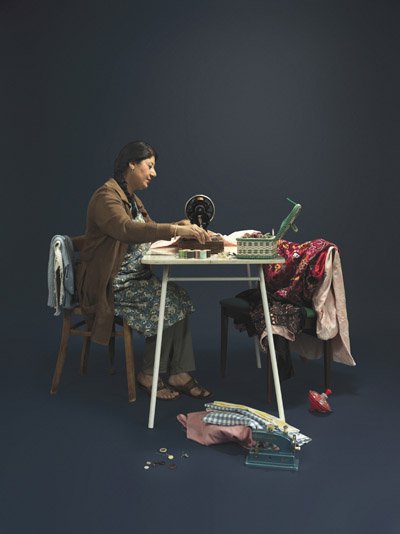
The print version of this article can be downloaded as a PDF file.
Dr Helen McCarthy is Reader in Modern British History at Queen Mary University of London. She has been a British Academy Mid-Career Fellow in 2017-18.
Today, the number of people in the UK who work regularly from home stands at over 4 million, representing nearly 14 per cent of the total labour-force. This striking statistic conjures a rosy picture of individuals seated at laptops in kitchens, spare bedrooms and garden sheds up and down the country, empowered by new technology and enlightened employers to set their working patterns in line with preferred lifestyles. Home-working is often talked up as an especially attractive option for women, who are still more likely than men to be juggling caring commitments with paid employment. Today, organisations which fail to offer this kind of flexibility are regarded as corporate laggards, unlikely to recruit or retain talented workers or to score high on diversity, equality and inclusion. The days of being chained to your desk, it seems, are on the way out.
A complicated past
Yet if home-working points to a brighter future, it also speaks to a complicated past. Before the Industrial Revolution, productive work was overwhelmingly centred on the household. A large proportion of the population lived on the land, cultivating crops and tending livestock either for the market or for family use. Others were engaged in cottage-based industries such as spinning and weaving, or plied their trades from workshops located in or attached to domestic dwellings. Many married couples ran inns and coffee houses or kept shops, a model of family partnership which persisted well into the Victorian era. In all cases, no line was rigidly drawn between ‘home’ and ‘work’.
The rise of the factory system, however, created a new vision of modernity. It was the power loom and steam engine, rather than the spindle or plough, which were now identified as the source of Britain’s economic pre-eminence. It was through technological innovation in the mill, on the railways and in the shipyard that wealth was created, and it was through conflict on the shop-floor that new social classes sprang into being and changed the course of history. The home, by contrast, was reimagined as a haven from market forces, a privatised space for recreation, spiritual uplift and the nurturing of children. Integral to this transformed social order was a powerful gender ideology which situated men in the public world of work and women in the domestic sphere, where they tended to their homes and families.
Yet for large numbers of women, the home remained a place for waged as well as unwaged labour. Rising incomes and urbanisation from the mid-19th century created a new demand for cheap consumer goods – everything from clothing and bed-linen to lampshades and umbrella-stands. Recruiting home-workers as a flexible labour-force was a smart business strategy for manufacturers looking to serve this volatile, fluctuating market. Home-work suited many women too, particularly wives who needed to earn but were prevented by household duties from seeking regular employment in a factory. By the 1890s and 1900s, hundreds of thousands of women in places like London, Birmingham, Leeds and Glasgow were sewing shirts, finishing trousers, gluing boxes, mending bags, pulling fur, stitching tennis balls, carding buttons, trimming hats, lacquering pots, polishing furniture and hammering chains in their own homes.
The end of sweated labour?
Some of these home-workers were highly-skilled and earned good wages, but others were in dire poverty and were vulnerable to exploitation by employers. It was this latter group who formed the chief target of Edwardian campaigns against ‘sweating’ – a term given to any form of waged labour in which hours were long, conditions insanitary and pay set too low to support even basic human subsistence. Socialists, trade unionists and progressive liberals condemned home-work as an evil which had no place in a modern civilisation. Women working at home for starvation wages fed ‘parasitic’ industries which thrived, as one agitator put it, ‘with the horrible rapidity and vigour of a poisonous creeper in a South American forest’.
Efforts by middle-class reformers led to Britain’s first minimum wage legislation – the Trade Boards Act of 1909 – and to a marked decline in sweated labour in the home. Yet low-paid industrial home-work never disappeared. It was even briefly revived by the government during the Second World War under the pressure of acute labour shortages on the home front. Married women who were unable to take up full-time factory jobs were encouraged to volunteer for ‘out-work’ in their homes or local village halls, assembling small components for key items of military hardware.
Home-work experienced a major resurgence in the 1970s and 1980s, most notably amongst small suppliers in the clothing industries of London, Yorkshire and the West Midlands. Prominent amongst those moving into new markets for cheap, retail fashion were male entrepreneurs from the Indian south-continent, who often employed women from their own families and migrant communities to sew garments in small workshops or at home. Some of these workers enjoyed using their skills to earn an income in the home, but many others endured conditions which bore striking similarities to the sweated industries of previous decades. They had little control over the quantity and flow of work, finding themselves swamped with rush orders one week and empty-handed the next. Piece-rates were low and home-workers’ employment status was ambiguous, with few receiving any holiday entitlement, sick pay or maternity benefit.
Throughout the century, these kinds of home-workers were never the helpless victims that middle-class reformers typically imagined them to be. In 1910, the chain-makers of Cradley Heath made national headlines by going on strike for ten weeks, successfully forcing employers to pay the higher piece-rates agreed under the Trade Boards Act. In the 1970s, home-workers organised again, aided by trade unionists and feminist activists in places like Hackney, Rochdale and Leicester. They challenged low pay, demanded proper employment rights and experimented with co-operative models of working. These campaigns did not solve every problem, but they proved beyond doubt that home-workers had the capacity to organise and take action against exploitation.
White-collar home-work
‘Sweated’ labour attracted the most attention from policy-makers, but working at home was embraced by other groups throughout the 19th and 20th centuries, including women of the educated middle and upper classes. Writing for money, for example, was considered to be a ‘respectable’ occupation for ladies, in part because it was a pastime that could be pursued at a table in the parlour or at a typewriter in the study and did not take women out of their ‘proper sphere’. Female doctors frequently established consulting rooms in their own homes. Elizabeth Garrett, the first British-qualified woman to appear on the Medical Register in 1865, ran a private practice at her London home on Upper Berkeley Street. Upon marriage to James Anderson in 1871, she insisted that the couple set up home there in order to minimise any disruption to her professional work. As late as the 1960s and 1970s, women in General Practice ran surgeries inside or next to the family home, while other graduate wives and mothers took up home-based work as proof-readers, translators, indexers, private tutors and music teachers.
Electronic cottages
A new future for the home-working professional appeared on the horizon with the rise of networked personal computing from the 1970s. Experts predicted that large numbers of office workers would soon be based at remote terminals in ‘electronic cottages’, freed from the grind of the daily commute and gifted with more time to spend with their families. In reality, ‘tele-working’ advanced very slowly, with employers proving reluctant to relinquish direct control over their workforces. Women who succeeded in negotiating home-working arrangements often found these to be far less flexible than the rhetoric suggested. Research showed that white-collar home-workers felt isolated and insecure, and were still spending large portions of their salaries on childcare in order to meet deadlines and attend on-site meetings.
Those opting for self-employment arguably benefited most from the development of new communication technologies. From the mid-1990s, a wave of female entrepreneurs established start-ups from their homes, often having given up high-pressure corporate careers after becoming mothers. These so-called ‘mumpreneurs’ – a term which divides opinion within the female business community – seem to have the best of both worlds, integrating their professional passions with the pleasures of family life. Yet being one’s own boss, as many successful businesswomen point out, can be all-consuming with no structures or boundaries to distinguish ‘work’ time from down-time. The Victorian ideal of the home as a place of rest and recuperation becomes impossible to realise when domestic space is organised around the demands of the job.
These four walls
This is the contemporary dilemma which faces all of us when the walls between ‘work’ and ‘home’ are collapsed. Some early advocates of tele-working envisaged a utopian future in which the harmonious order of the old household economy would be reconfigured for the post-industrial age. By banishing the mindset of rigid shop-floor discipline and centralised corporate structures, everyone could enjoy a freer, more autonomous existence. This romanticised vision has not materialised, even for the minority of high-earning professionals who have a considerable degree of control over the location and hours of their work. Careers still tend to be made by those who show their faces: at meetings, networking events, drinks after work, and chats around the water-cooler. There is a very real danger that where home-working policies become too strongly branded as a ‘family-friendly’ option for women, gender segregation is further entrenched. Such policies also distract attention from the toxic workplace cultures, inadequate childcare provision and unequal sharing of domestic labour which make home-working attractive to so many women in the first place.
In short, the many faces of women’s home-work remind us that debates about ‘flexibility’ and ‘precarity’ in the contemporary labour market are nothing new. The question of where we do our jobs, just like questions of pay, hours and employment rights, has always been an object of political struggle. Far from providing a shelter from battles over the meaning of work, home has been integral to them.

These Four Walls, an exhibition created by Helen McCarthy and Leonora Saunders, explores the multiple meanings of women’s home-work through a fusion of historical research and portrait photography. It has been on display at the British Academy’s Summer Showcase, 22-23 June 2018. Share your experiences of working at home using the hashtag #TheseFourWalls
How are we doing? Your feedback is important to help us shape future issues of the British Academy Review.
To provide reader feedback, please visit www.britishacademy.ac.uk/british-academy-review-feedback